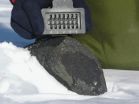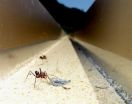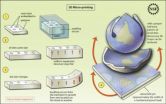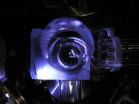(Press-News.org) Creating some of life's building blocks in space may be a bit like making a sandwich – you can make them cold or hot, according to new NASA research. This evidence that there is more than one way to make crucial components of life increases the likelihood that life emerged elsewhere in the Universe, according to the research team, and gives support to the theory that a "kit" of ready-made parts created in space and delivered to Earth by impacts from meteorites and comets assisted the origin of life.
In the study, scientists with the Astrobiology Analytical Laboratory at NASA's Goddard Space Flight Center in Greenbelt, Md., analyzed samples from fourteen carbon-rich meteorites with minerals that indicated they had experienced high temperatures – in some cases, over 2,000 degrees Fahrenheit. They found amino acids, which are the building blocks of proteins, used by life to speed up chemical reactions and build structures like hair, skin, and nails.
Previously, the Goddard team and other researchers have found amino acids in carbon-rich meteorites with mineralogy that revealed the amino acids were created by a relatively low-temperature process involving water, aldehyde and ketone compounds, ammonia, and cyanide called "Strecker-cyanohydrin synthesis."
"Although we've found amino acids in carbon-rich meteorites before, we weren't expecting to find them in these specific groups, since the high temperatures they experienced tend to destroy amino acids," said Dr. Aaron Burton, a researcher in NASA's Postdoctoral Program stationed at NASA Goddard. "However, the kind of amino acids we discovered in these meteorites indicates that they were produced by a different, high-temperature process as their parent asteroids gradually cooled down." Burton is lead author of a paper on this discovery appearing March 9 in Meteoritics and Planetary Science.
In the new research, the team hypothesizes the amino acids were made by a high-temperature process involving gas containing hydrogen, carbon monoxide, and nitrogen called "Fischer-Tropsch" –type reactions. They occur at temperatures ranging from about 200 to 1,000 degrees Fahrenheit with minerals that facilitate the reaction. These reactions are used to make synthetic lubricating oil and other hydrocarbons; and during World War II, they were used to make gasoline from coal in an attempt to overcome a severe fuel shortage.
Researchers believe the parent asteroids of these meteorites were heated to high temperatures by collisions or the decay of radioactive elements. As the asteroid cooled, Fischer-Tropsch-type (FTT) reactions could have happened on mineral surfaces utilizing gas trapped inside small pores in the asteroid.
FTT reactions may even have created amino acids on dust grains in the solar nebula, the cloud of gas and dust that collapsed under its gravity to form the solar system. "Water, which is two hydrogen atoms bound to an oxygen atom, in liquid form is considered a critical ingredient for life. However, with FTT reactions, all that's needed is hydrogen, carbon monoxide, and nitrogen as gases, which are all very common in space. With FTT reactions, you can begin making some prebiotic components of life very early, before you have asteroids or planets with liquid water," said Burton.
In the laboratory, FTT reactions produce amino acids, and can show a preference for making straight-chain molecules. "In almost all of the 14 meteorites we analyzed, we found that most of the amino acids had these straight chains, suggesting FTT reactions could have made them," said Burton.
It's possible that both Strecker and FTT processes could have contributed to the supply of amino acids in other meteorites. However, evidence for the FTT reaction would tend to get lost because FTT reactions create them in much lower abundances than Strecker synthesis. If an asteroid with an initial amino acid supply from FTT reactions was later altered by water and Strecker synthesis, it would overwrite the small contribution from the FTT reactions, according to the team.
The team believes the majority of the amino acids they found in the 14 meteorites were truly created in space, and not the result of contamination from terrestrial life, for a few reasons. First, the amino acids in life (and in contamination from industrial products) are frequently linked together in long chains, either as proteins in biology or polymers in industrial products. Most of the amino the amino acids discovered in the new research were not bound up in proteins or polymers. In addition, the most abundant amino acids found in biology are those that are found in proteins, but such "proteinogenic" amino acids represent only a small percentage of the amino acids found in the meteorites. Finally, the team analyzed a sample of ice taken from underneath one of the meteorites. This ice had only trace levels of amino acids suggesting the meteorites are relatively pristine.
The experiments showing FTT reactions produce amino acids were performed over 40 years ago. The products have not been analyzed with modern techniques, so the exact distributions of amino acid products have not been determined. The team wants to test FTT reactions in the laboratory using a variety of ingredients and conditions to see if any produce the types of amino acids with the abundances they found in the 14 meteorites.
The team also wants to expand their search for amino acids to all known groups of carbon-rich meteorites. There are eight different groups of carbon-rich meteorites, called "carbonaceous chondrites." The new work adds two additional groups to the three previously known to have produced amino acids, leaving three groups to be tested. These three remaining groups have a high metal content as well as evidence for high temperatures. "We'll see if they have amino acids also, and hopefully gain some insight into how they were made," says Burton. When the team began looking for amino acids in carbon-rich meteorites, it was considered somewhat of a long shot, but now: "We would be surprised if we didn't discover amino acids in a carbon-rich meteorite," says Burton.
INFORMATION:
The research was funded by the NASA Astrobiology Institute (NAI), the Goddard Center for Astrobiology, and the NASA Cosmochemistry Program. NAI is managed by NASA Ames Research Center in Mountain View, Calif. Dr. Burton was supported by the NASA Postdoctoral Program, administered by Oak Ridge Associated Universities through a contract with NASA. Meteorite samples were provided by Dr. Kevin Righter of NASA's Johnson Space Center, Houston, Texas.
Meteorites reveal another way to make life's components
2012-03-12
ELSE PRESS RELEASES FROM THIS DATE:
Infection control certification associated with lower MRSA infection rates
2012-03-12
Washington, DC, March 9, 2012 -- Hospitals whose infection prevention and control programs are led by a director who is board certified in infection prevention and control have significantly lower rates of methicillin-resistant Staphylococcus aureus (MRSA) bloodstream infections (BSI) than those that are not led by a certified professional, according to a new study published in the March issue of the American Journal of Infection Control, the official publication of APIC - the Association for Professionals in Infection Control and Epidemiology.
A team of researchers ...
Orientation of desert ants: Every cue counts
2012-03-12
Desert ants have adapted to a life in a barren environment which only provides very few landmarks for orientation. Apart from visual cues and odors the ants use the polarized sunlight as a compass and count their steps in order to return safely to their home after searching for food. In experiments with ants of the genus Cataglyphis in their natural habitats in Tunisia and Turkey, behavioral scientists of the Max Planck Institute for Chemical Ecology in Jena, Germany, have now discovered that ants can also use magnetic and vibrational landmarks in order to find their way ...
Researchers 'print' polymers that bend into 3-D shapes
2012-03-12
Christian Santangelo, Ryan Hayward and colleagues at the University of Massachusetts Amherst recently employed photographic techniques and polymer science to develop a new technique for printing two-dimensional sheets of polymers that can fold into three-dimensional shapes when water is added. The technique may lead to wide ranging practical applications from medicine to robotics
The journal Science publishes the research in its March 9 issue.
Researchers used a photomask and ultraviolet (UV) light to "print" a pattern onto a sheet of polymers, a technique called photolithography. ...
Genetic marker for painful food allergy points to improved diagnosis, treatment
2012-03-12
Researchers have identified a genetic signature for a severe, often painful food allergy – eosinophilic esophagitis – that could lead to improved diagnosis and treatment for children unable to eat a wide variety of foods.
The scientists, from Cincinnati Children's Hospital Medical Center, report in the Journal of Allergy and Clinical Immunology that they have pinpointed a dysregulated microRNA signature for eosinophilic esophagitis (EoE), a disease that also may cause weight loss, vomiting, heartburn and swallowing difficulties.
Interestingly, the dysregulated microRNA ...
New 'pendulum' for the ytterbium clock
2012-03-12
The faster a clock ticks, the more precise it can be. Due to the fact that lightwaves vibrate faster than microwaves, optical clocks can be more precise than the caesium atomic clocks which presently determine time. The Physikalisch-Technische Bundesanstalt (PTB) is even working on several of such optical clocks simultaneously. The model with one single ytterbium ion caught in an ion trap is now experiencing another increase in accuracy. At PTB, scientists have succeeded in exciting a quantum-mechanically strongly "forbidden" transition of this ion and – in particular – ...
Iridescent, feathered dinosaur: New evidence that feathers evolved to attract mates
2012-03-12
The detailed feather pattern and color of Microraptor--a pigeon-sized, four-winged dinosaur that lived about 120 million years ago--had a glossy iridescent sheen.
Its tail was narrow and adorned with a pair of streamer feathers, suggesting the importance of display in the early evolution of feathers, say scientists reporting the findings in this week's issue of the journal Science.
By comparing the patterns of pigment-containing organelles from a Microraptor fossil to those in modern birds, the scientists determined that the dinosaur's plumage was iridescent with a ...
NOHO Dental Group Now Offers Several Special Promotions for New and Existing Patients
2012-03-12
NOHO Dental Group and Dr. Afar, North Hollywood dentist, are offering a variety of specials for new and existing patients. For a short time, patients can receive discounts on a wide number of dental procedures, allowing both new patients and those who have been with the NOHO Dental Group for years to save money and try new dental services.
These specials include a wide variety of services, such as a $49 dental exam with x-rays for new patients. For patients who need preventative care like dental cleanings, this special allows new patients to try out the services of Dr. ...
NIH study links childhood cancer to developmental delays in milestones
2012-03-12
Infants and toddlers who have been treated for cancer tend to reach certain developmental milestones later than do their healthy peers, say researchers at the National Institutes of Health and in Italy.
The findings show that delays may occur early in the course of treatment and suggest that young children with cancer might benefit from such early interventions as physical or language therapy.
Compared to children who had not had cancer, children treated for cancer before age 4 progressed more slowly in vocabulary, cognitive functions such as attention and memory, and ...
Cultural differences may impact neurologic and psychiatric rehabilitation of Spanish speakers
2012-03-12
Amsterdam, NL, 9 March 2012 – The number of people with neurological and psychiatric disorders in Spanish-speaking countries has increased over the past two decades. The February issue of NeuroRehabilitation assesses important factors that should be considered in rehabilitating Spanish-speaking individuals suffering from these disorders.
"Though much work has been done in this area for Anglo-Saxon populations, very little work has focused on Spanish-speaking individuals," says Guest Editor Juan Carlos Arango-Lasprilla, PhD, of the Department of Physical Medicine and ...
In recognizing faces, the whole is not greater than the sum of its parts
2012-03-12
How do we recognize a face? To date, most research has answered "holistically": We look at all the features—eyes, nose, mouth—simultaneously and, perceiving the relationships among them, gain an advantage over taking in each feature individually. Now a new study overturns this theory. The researchers—Jason M. Gold and Patrick J. Mundy of the Indiana University and Bosco S. Tjan of the University of California Los Angeles—found that people's performance in recognizing a whole face is no better than their performance with each individual feature shown alone. "Surprisingly, ...





